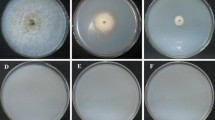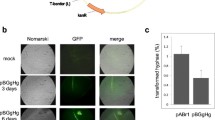Abstract
A genetically fertile, trichothecene-producing plant pathogen, Gibberella pulicaris (Fusarium sambucinum), was transformed with three different vectors: cosHyg1, pUCH1, and pDH25. All three vectors carry hph (encoding hygromycin B phosphotransferase) as the selectable marker. Transformation frequency was 0.03 transformants per μmg of DNA for pDH25 and 0.5 for pUCH1 or cosHyg1. The vector DNA sequences integrated at different sites into the fungal genome. Transformants were classified into three types based upon distinctive integration patterns: type A contained a single, intact copy of the vector at one site per genome; type B contained multiple tandem copies or a combination of single and multiple tandem copies at one or more sites per genome; type C contained a partial vector copy at one site per genome. While the transformants with cosHyg1 and pUCH1 were type A or B, type C was unique to pDH25 transformants. Type A and C transformants were both meiotically and mitotically stable. However, type B multiple inserts were unstable in mitosis and meiosis since: (1) multiple tandem copies were deleted: (2) rearrangements occurred during premeiosis; and (3) inserts in one of the type B transformants became methylated during premeiosis. Differential expression of transforming sequences between spore germination and mycelial growth was also observed among type B transformants. The ability to transform G. pulicaris with the resulting varied features of integration patterns and the behavior of transforming DNA during mitosis and meiosis provides a means to isolate, manipulate, and study cloned genes in this mycotoxin-producing plant pathogen.
Similar content being viewed by others
References
Beremand MN (1989) Mycopathologia 107:67–74
Booth C (1971) The genus Fusarium. Commonwealth Mycological Institute, Kew, England, pp 168–171
Coppin-Raynal E, Picard M, Arnaise S (1989) Mol Gen Genet 219:270–276
Churchill ACL, Ciuffetti LM, Hansen DR, Van Etten HD, Van Alfen NK (1990) Curr Genet 17:25–31
Cullen D, Leong SA, Wilson LJ, Henner DJ (1987) Gene 57:21–26
Desjardins AE, Beremand MN (1987) Phytopathology 77:678–683
Desjardins AE, Gardner HW (1989) Mol Plant-Microbe Inter 2:26–34
Desjardins AE, Gardner HW, Plattner RD (1989) Phytochemistry 28:431–437
Dickman MB, Partridge JE (1989) Theor Appl Genet 77:535–539
Farman ML, Oliver RP (1988) Curr Genet 13:327–330
Fincham JRS (1989) Microbiol Rev 53:148–170 Foss ES, Garrett PW, Kinsey JA, Selker EU (1991) Genetics 127:711–717
Garber RC, Yoder OC (1983) Anal Biochem 135:416–422
Goosen TC, Bos J, van dan Broek H (1992) Transformation and gene manipulation in filamentous fungi: an overview. In: Arora DK, Elander RP, Mukerji KG, (eds) Handbook of applied mycology, vol 4. Marcel Dekker, New York, pp 151–195
Goyon C and Faugeron G (1989) Mol Cell Biol 9:2818–2827
Hoh TM, Desjardins AE (1992) Mol Plant-Microbe Inter 5:249–256
Hynes MJ (1986) Exp Mycol 10:1–8
Johnston JB, Gunsalus IC (1977) Biochem Biophys Res Commun 75:13–17
Johnstone IL, Hughes SG, Clutterbuck AJ (1985) EMBO J 4:1307–1311
Keller NP, Bergstrom GC, Yoder OC (1991) Curr Genet 19:227–233
Kelly MK, Hynes MJ (1985) EMBO J 4:475–479
Kistler HC, Benny UK (1988) Curr Genet 13:145–149
LeChevanton L, Leblon G, Lebilcot S (1989) Mol Gen Genet 218:390–396
Lusky M, Botchan M (1981) Nature 293:79–81
Maniatis T, Fritsch EF, Sambrook J (1982) Molecular cloning: a laboratory manual. Cold Spring Harbor Laboratory, Cold Spring Harbor, New York
Oliver RP, Roberts IN, Harling R, Kenyon L, Punt PJ, Dingemanse MA, van den Hondel CAMJJ (1987) Curr Genet 12:231–233
Parsons KA, Chumley FG, Valent B (1987) Proc Natl Acad Sci USA 84:4161–4165
Penttila M, Nevalainen H, Ratto M, Salminen E, Knowles J (1987) Gene 61:155–164
Pouwels PH (1985) Curr Genet 9:361–368
Razanamparany V, Bequeret J (1988) Gene 74:399–409
Rodriguez RJ, Yoder OC (1987) Gene 54:83–87
Salch YP, Beremand MN (1988) J Cell Biochem suppl 12C:290
Salch YP, Shaw PD (1988) J Bacteriol 170:2584–2591
Selker EU (1990) Annu Rev Genet 24:579–613
Selker EU, Garrett PW (1988) Proc Natl Acad Sci USA 85:6870–6874
Selker EU, Cambareri EB, Jensen BC, Haack KA (1987) Cell 51:741–752
Timberlake WE and Marshall (1989) Science 244:1313–1317
Turgeon BG, Garber RC, Yoder OC (1985) Mol Gen Genet 201:450–453
Turgeon BG, Garber RC, Yoder OC (1987) Mol Cell Biol 7:3297–3305
Upshall A (1992) The application of molecular genetic methods to filamentous fungi. In: Arora DK, Elander RP, Mukerji KG, (eds) Handbook of applied mycology, vol 4. Marcel Dekker, New York, pp 81–99
Wernars K, Goosen T, Wennekes LMJ, Visser J, Bos CJ, van den Broek HWJ, van Gorcom RFM, van den Hondel CAMJJ, Pouwels PH (1985) Curr Genet 9:361–368
Author information
Authors and Affiliations
Additional information
Communicated by O.C.Yoder
Mention of companies or products by name does not imply the endorsement by the U.S. Department of Agriculture over others not cited
Rights and permissions
About this article
Cite this article
Salch, Y.P., Beremand, M.N. Gibberella pulicaris transformants: state of transforming DNA during asexual and sexual growth. Curr Genet 23, 343–350 (1993). https://doi.org/10.1007/BF00310897
Received:
Accepted:
Issue Date:
DOI: https://doi.org/10.1007/BF00310897




